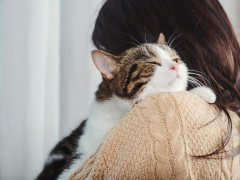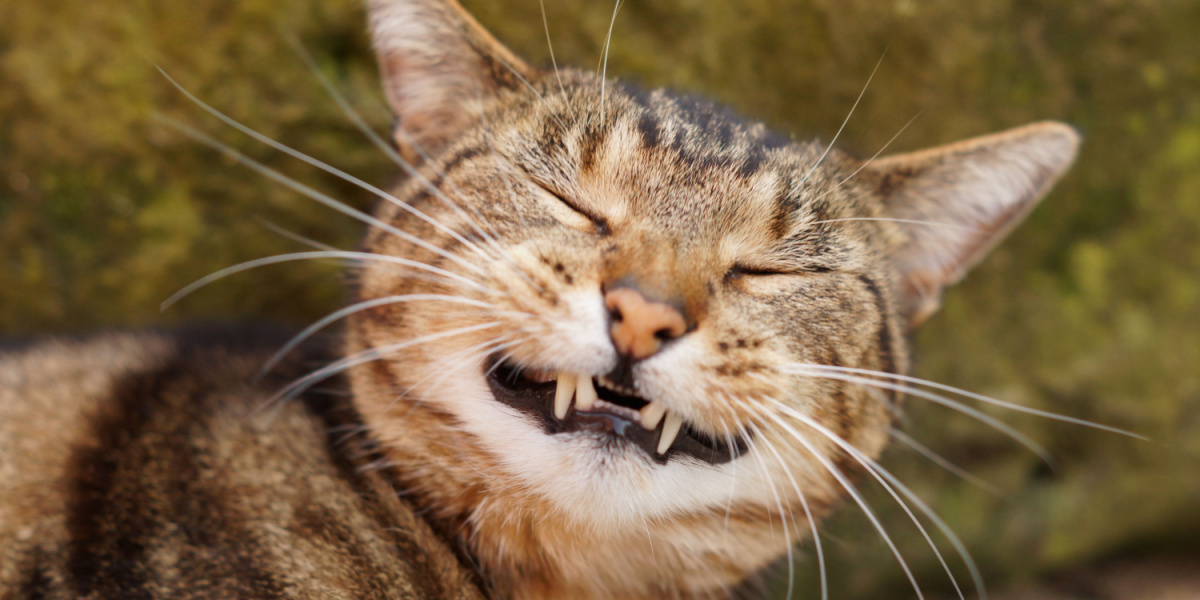
If your veterinarian has diagnosed your cat with dental disease, you’re in good company!
Dental disease is a relatively common problem, affecting the majority of adult cats. In fact, some studies estimate that dental disease affects as many as 85% to 90% of pet cats more than than 3 years old.
Fortunately, most cases of dental disease can be successfully treated. With careful attention to home dental care, you may also be able to prevent the future recurrence of your cat’s dental disease.
Quick Overview: Dental Disease in Cats




What Is Dental Disease in Cats?
The term “dental disease” is used to refer to a number of conditions affecting the teeth and gums. There are three primary types of dental disease that commonly occur in cats:
- Gingivitis: inflammation of the gums
- Periodontitis: inflammation of the bone and connective tissues that underly the gums
- Tooth resorption: the breakdown of teeth
In most cases, feline dental disease is a progressive condition. Cats first develop gingivitis, which may be associated with subtle redness and swelling of the gums. As the cat’s dental disease becomes more advanced, this gum inflammation spreads to deeper tissues, including the bones of the jaw, resulting in periodontitis.
Over time, chronic dental disease leads to tooth resorption in cats. Unlike human cavities, which begin on the surface of the tooth and progress inwards toward the center of the tooth, tooth resorption is a process that begins deep inside the tooth.
By the time it becomes visible, significant damage has already occurred. Tooth resorption is, unfortunately, a common condition in cats. It is also very painful for cats, contributing to much of the pain that is associated with dental disease.
Causes of Dental Disease in Cats
There are many potential causes of dental disease in cats. In most cases, dental disease is associated with tooth decay, much as it is in humans. However, there can also be other factors involved in dental disease.
1. Plaque and Tartar
Do you ever wake up in the morning and feel a slightly “fuzzy” coating on your teeth, before you brush them? If so, that’s plaque. Plaque is an accumulation of leftover food particles, saliva, and bacteria that occurs on the teeth. You can remove plaque easily with brushing.
When plaque remains on the teeth for 36 to 48 hours, however, it hardens into a firm coating known as tartar. This tartar cannot be removed with brushing. Tartar can serve as a home to even more bacteria.
Plaque and tartar cause the most damage at your cat’s gum line. When the bacteria that are found in plaque and tartar meet the delicate tissues of your cat’s gums, they trigger the immune system to respond. This results in gingivitis and periodontitis.
2. Viral Conditions
Feline leukemia virus (FeLV) and feline immunodeficiency virus (FIV) have both been observed to increase the risk of dental disease in cats. The gingivitis induced by viral infection can be severe.
We don’t know exactly why these viruses contribute to dental disease. However, we suspect that it has to do with the way in which these viruses affect the immune system. An altered immune response to the bacteria in your cat’s mouth can lead to significant stomatitis.
3. Other Medical Conditions
Other underlying medical conditions may predispose a cat to dental disease. For example, a connection has been observed between dental disease and chronic kidney disease.
We aren’t entirely sure which comes first—the dental diseases or the kidney disease—but there appears to be an interaction between these two conditions. Cats with diabetes mellitus are also more likely to develop significant dental problems, perhaps because of the effects of diabetes on the immune system.
4. Autoimmune Disease
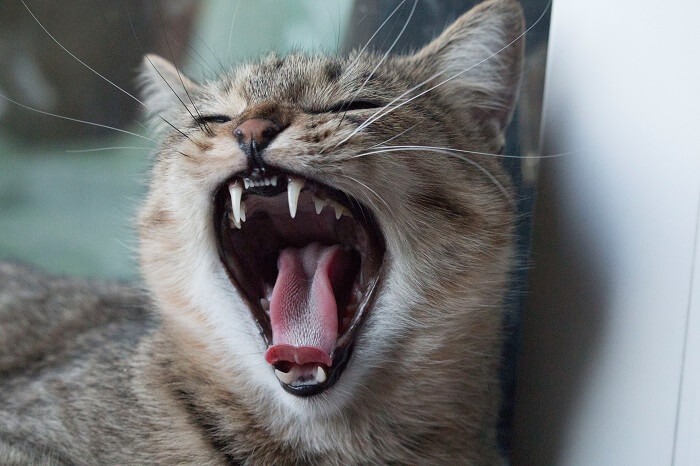
Autoimmune conditions may predispose a cat to dental disease.
Some cats seem to be predisposed to severe dental disease, without any other identifiable risk factors. In these cats, even daily brushing and regular dental cleanings may be inadequate to prevent gingivitis, periodontitis, and tooth resorption. These cats might have a form of autoimmune disease, which causes them to overreact to the bacteria that are present in their mouths.
Signs of Dental Disease in Cats
The signs of dental disease can vary dramatically, depending on the severity of your cat’s dental disease.
In the early stages, you may notice mild redness and swelling of your cat’s gums on close examination. At this stage, your cat will likely be eating normally and not showing any overt signs of pain.
As your cat’s dental disease progresses to periodontitis, you may notice more obvious signs of dental disease. Your cat’s gums may become increasingly red and swollen, and you may notice some loose or missing teeth. Bleeding at the gum line is common, so you may notice some blood in your cat’s saliva or water bowl.
Cats with periodontitis are typically uncomfortable, which can lead to excessive drooling and pawing at the mouth. Your cat may be reluctant to eat. They may chew on just one side of the mouth, holding their head at an angle while eating. You may also notice that your cat has exceptionally bad breath.
Tooth resorption, like periodontitis, causes pain and discomfort. If you look closely at your cat’s teeth, however, you may notice small pink defects on the surface of the tooth. These defects are often most visible on the gum line, although they may also appear on other parts of the teeth.
Treatment of Dental Disease in Cats
The first step to treating dental disease is to have your veterinarian perform a comprehensive dental cleaning and oral health evaluation. This will allow your veterinarian to identify and diagnose any dental problems, then move forward with treatment.
A feline dental cleaning is always performed under general anesthesia. Unlike human patients, a cat cannot be trusted to lay completely still with their mouth open for the length of time that is required for a dental procedure. (While you may see ads for “anesthesia-free dentistry,” these services are in no way regarded as a substitute for a thorough dental cleaning and evaluation.)
Once your cat is anesthetized, a veterinary technician will scale all of the tartar from your cat’s teeth. They will pay special attention to the tartar along and under the gum line, because this is what contributes most dramatically to dental disease.
Next, the veterinary technician will take radiographs (x-rays) of your cat’s teeth. Because most dental disease involves changes below the gum line, dental radiographs are an important component of a thorough dental evaluation.
Once your cat’s teeth have been cleaned and radiographs have been taken, the veterinarian will carefully examine your cat’s teeth. They will probe your cat’s gums will be probed extensively, looking for pockets in the gums that may indicate periodontitis.
The veterinarian will examine your cat’s teeth closely, looking for resorptive lesions or other indications of dental disease. The veterinarian will also review your cat’s dental radiographs, looking for evidence of pathology below the gum line.
Based upon their findings, your veterinarian will make treatment recommendations. Severely diseased teeth are often extracted, while gingivitis and/or mild periodontitis may be addressed through scaling and polishing.
Your veterinarian may discharge your cat on pain medication and antibiotics after their dental cleaning. The first few days after a deep dental cleaning can be uncomfortable, especially in cases of severe gingivitis or periodontitis, so your veterinarian may recommend pain medication even in the absence of extractions. Antibiotics are often recommended for cats with periodontitis or dental extractions, to reduce the risk of oral infection.
Prevention of Dental Disease in Cats
The best way to prevent dental disease in cats is through daily toothbrushing. In most cases, especially if you begin from an early age, cats can be trained to tolerate and even enjoy daily brushing.
If daily brushing isn’t an option for your cat, however, there are a variety of other home dental care options. Dental chews, oral hygiene rinses, and prescription diets can all serve as beneficial alternatives to daily brushing.
1. Feline Toothbrushing
When brushing your cat’s teeth, it’s important to use feline-specific toothbrushes and toothpaste. Human toothpaste contains fluoride, which can be toxic to cats. Cat toothbrushes are easier to use, because they fit into a cat’s small mouth.
Acclimate your cat to toothbrushing slowly. The first week, don’t even try to completely brush your cat’s teeth. Instead, focus on convincing your cat to lick a small amount of toothpaste from your finger and then from the toothbrush. Once your cat is readily accepting toothpaste from the toothbrush, spend several days trying to brush just one tooth. Focus on making the experience positive for your cat, and don’t worry about brushing all of your cat’s teeth.
End on a high note, before your cat becomes stressed, and always follow each brushing attempt with a tasty reward. Over a period of several weeks, as your cat’s tolerance for toothbrushing increases, you can gradually work toward brushing all of the teeth in a single sitting.
Once your cat is acclimated to toothbrushing, brush your cat’s teeth every day. While you may have to miss a day of brushing every now and then, be aware that skipping just one day of brushing will increase the amount of tartar on your cat’s teeth.
2. Oral Hygiene Rinses
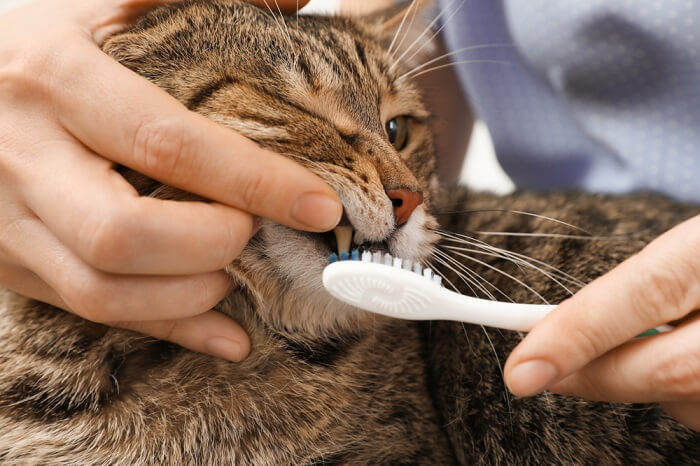
If brushing your cat’s teeth is stressful for either cat or human, an oral rinse might be a more convenient alternative.
If your cat will tolerate your hands in their mouth but not for long enough to brush, an oral hygiene rinse can be an appealing alternative. These rinses essentially work like pet mouthwash. They contain antibacterial substances or enzymatic cleaners that minimize the growth of bacteria within your cat’s mouth. Use an oral hygiene rinse once daily or according to the label recommendations.
3. Dental Chews
While the phrase “dental chew” may make you think of dogs, some cats also enjoy cat-specific dental treats. Dental chews scrape plaque and tartar off the teeth as your cat chews. There are several different brands available, and they differ slightly in flavor and consistency. Give dental chews anywhere from once daily to a few times daily, depending on the package label recommendations.
4. Prescription Diets
Like dental chews, prescription dental diets scrape plaque and tartar off your cat’s teeth. While many cats tend to swallow their kibble whole, prescription diets have larger pieces of kibble.
These kibbles also have characteristics that prevent them from shattering when bitten into, maximizing the likelihood that they will scrape your cat’s teeth clean with each bite. If your cat is eating a prescription dental diet, they typically should receive this diet at every mealtime.
5. Regular Dental Cleanings
Even with appropriate home care, most cats will still need to have their teeth cleaned by a veterinarian periodically. (Remember, most humans brush their teeth twice daily and still see their dental hygienist every six months!)
Your cat might need dental cleanings every one to three years, depending on the success of your home dental care and your veterinarian’s recommendations. Regular dental cleanings allow the removal of tartar and the early detection of problems, minimizing the risk of severe or advanced dental disease.
Dental Disease: Final Thoughts
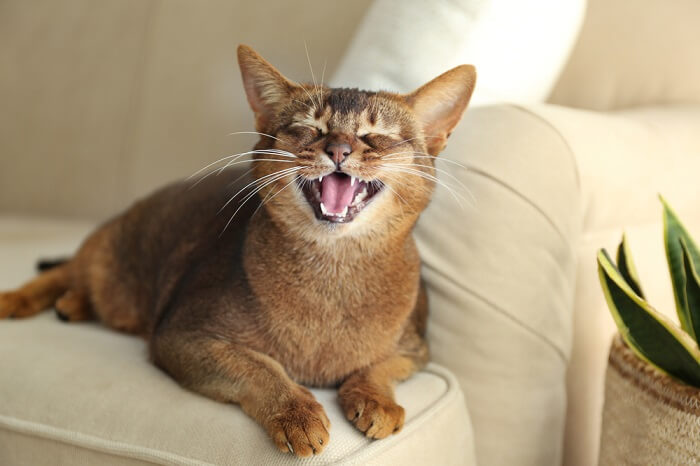
With the right steps, dental disease in cats can be prevented and treated for a happier, healthier cat.
Feline dental disease is a common condition, but it doesn’t have to be an unavoidable fact of feline life. Work with your veterinarian to address your cat’s current dental health, then develop a home care plan to prevent dental disease long-term. By paying careful attention to your cat’s teeth, you can improve their quality of life and reduce the risk of serious medical problems.
Also Read: What To Do If Your Cat Chews On Everything
Frequently Asked Questions
Can dental disease in cats be cured?
With appropriate veterinary treatments, most cases of dental disease can be cured. Your veterinarian may recommend a number of treatments, including regular dental cleanings, extraction of diseased teeth, and daily preventive care at home.
What are the signs of dental disease in cats?
The earliest sign of dental disease in cats is red, swollen gums. If dental disease is not addressed at this stage, signs of more advanced dental disease may include bleeding from the gums, pawing at the mouth, increased salivation, and reluctance to eat.
How long do cats live with periodontal disease?
Periodontal disease can affect your cat’s life expectancy if left untreated. With appropriate treatment, your cat can be expected to live a normal healthy life.
Can cats live with dental disease?
Dental disease can negatively affect a cat’s quality of life and impact their lifespan, if untreated. With appropriate treatment, most cases of dental disease can be cured and the cat will go on to live a healthy life.





